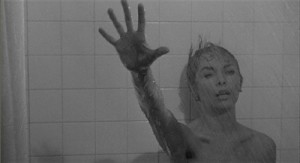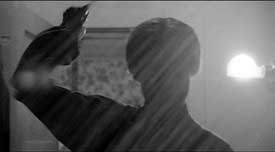 I’m a little late jumping on the 50th anniversary of the release of Psycho (which opened June 16th 1960), but I had the opportunity recently to attend a special event with the San Francisco Symphony — a screening of the film while the symphony performed Bernard Herrmann’s iconic score live. Knowing what I’ve read about the reportedly temperamental Herrmann, I’m sure he would have hated to hear his music in the concert hall accompanied by the sounds of the movie. As a film music geek, I would have preferred a performance of the complete Psycho score by itself, but I still knew I was experiencing something quite special. I have to admit a couple of times that I got caught up in the film and suddenly became aware that music was playing, which is saying a lot for someone like me.
I’m a little late jumping on the 50th anniversary of the release of Psycho (which opened June 16th 1960), but I had the opportunity recently to attend a special event with the San Francisco Symphony — a screening of the film while the symphony performed Bernard Herrmann’s iconic score live. Knowing what I’ve read about the reportedly temperamental Herrmann, I’m sure he would have hated to hear his music in the concert hall accompanied by the sounds of the movie. As a film music geek, I would have preferred a performance of the complete Psycho score by itself, but I still knew I was experiencing something quite special. I have to admit a couple of times that I got caught up in the film and suddenly became aware that music was playing, which is saying a lot for someone like me.
 There is very little doubt that director Alfred Hitchcock and composer Bernard Herrmann were masters of their craft and one of the great cinematic collaborations in the history of film. Their first film together was the black comedy The Trouble with Harry (1955), about a corpse that keeps showing up at rather inconvenient times, the theme for which can be heard now in a Volkswagen commercial (something else I’m sure Herrmann would’ve hated). Their second collaboration was The Man Who Knew Too Much (1956), a remake of Hitchcock’s own 1934 version, featuring Herrmann in a cameo conducting Arthur Benjamin’s Storm Clouds cantata during the film’s suspenseful climax at the Royal Albert Hall.
There is very little doubt that director Alfred Hitchcock and composer Bernard Herrmann were masters of their craft and one of the great cinematic collaborations in the history of film. Their first film together was the black comedy The Trouble with Harry (1955), about a corpse that keeps showing up at rather inconvenient times, the theme for which can be heard now in a Volkswagen commercial (something else I’m sure Herrmann would’ve hated). Their second collaboration was The Man Who Knew Too Much (1956), a remake of Hitchcock’s own 1934 version, featuring Herrmann in a cameo conducting Arthur Benjamin’s Storm Clouds cantata during the film’s suspenseful climax at the Royal Albert Hall.
This was immediately followed the same year by The Wrong Man and then in 1958 with what many consider to be their strongest collaboration, Vertigo. My personal favorite though would be their next film North By Northwest (1959), with its fandango-inspired main theme.
Following Psycho, Herrmann received a “sound consultant” credit for the electronic bird sounds in The Birds (1963) — the film itself has no background score. Marnie was their next project the following year and would be the last Alfred Hitchcock film released with a score by Bernard Herrmann.
Their falling-out occurred during their next project Torn Curtain (1966), where Hitchcock (reportedly under pressure from Universal) was looking for a more accessible “commercial” score with a “pop” love tune and Herrmann delivered a score written primarily for french horns, flutes, trombones, cellos and basses, along with timpani and two tubas. According to several accounts, Hitchcock ended the recording session before the day’s recording was over and ended up hiring Tom Jones composer John Addison to write a new score. (The rejected Herrmann score was recorded by Elmer Bernstein in 1977 and again by Joel McNeely in 1998 — and snippets of it showed up in Bernstein’s adaptation of Herrmann’s 1962 Cape Fear score for the 1991 Martin Scorsese remake).
An interesting account of the Torn Curtain incident occurs in the Oscar-nominated 1992 documentary Music for the Movies: Bernard Herrmann, spread over the two clips below, including a clip of Torn Curtain with Herrmann’s score restored.
[kml_flashembed movie="http://www.youtube.com/v/Dby0fHXTKSM" width="600" height="344" allowfullscreen="true" fvars="fs=1" /]
[kml_flashembed movie="http://www.youtube.com/v/gpjfW-_iQQc" width="600" height="344" allowfullscreen="true" fvars="fs=1" /]
Throughout his career, Herrmann has enjoyed composing for unusual instrumentation, such electric piano, electric strings and the theremin in The Day the Earth Stood Still (1951); a larger-than-normal harp section in Beneath the 12-Mile Reef (1953); wooden xylophones for the skeleton fight in The 7th Voyage of Sinbad (1958); and brass, woodwinds, organ and a serpent in Journey to the Center of the Earth (1959).
For Psycho, Herrmann chose an orchestra consisting of only strings, as it turns out mainly for budgetary reasons, but also to compliment the black and white cinematography of the film. (Interestingly, three years later his score for Jason and the Argonauts would have everything except strings — essentially a massive symphonic band with four harps).
The Prelude, with the disjointed main title lettering by the great Saul Bass, sets the tone. It’s interesting because nothing horrifying happens in the first act, but Herrmann and Bass have let us know that something very unsettling is going to eventually occur.
 Clearly one of the most famous marriages of image and music is the shower sequence in Psycho. It’s interesting to me how audiences laugh now when watching this scene or hearing those screeching strings, though I doubt anyone was laughing in theaters in 1960 after watching Janet Leigh (as Marion Crane) — supposedly the star of the movie — get stabbed to death 48 minutes into the picture.
Clearly one of the most famous marriages of image and music is the shower sequence in Psycho. It’s interesting to me how audiences laugh now when watching this scene or hearing those screeching strings, though I doubt anyone was laughing in theaters in 1960 after watching Janet Leigh (as Marion Crane) — supposedly the star of the movie — get stabbed to death 48 minutes into the picture.
The shower sequence (storyboarded by Saul Bass) is about 3 minutes long and has something like 50 cuts in it. For those who haven’t watched it in a while, you might be surprised to learn that you never once see the knife penetrate the body — save for 3 frames. The brutality of it all is achieved by cutting away from actually showing the violence and letting her reaction (i.e. screaming) and the sounds of the stabbing carry most of the intensity.
 And the music of course. But what’s interesting is that Hitchcock specifically instructed Herrmann to avoid writing music for this scene — he felt it would more terrifying without any underscore. But Herrmann disagreed and wrote music for the scene anyway and (so the story goes) when Hitchcock saw the scene with the music, he knew his composer had been right all along.
And the music of course. But what’s interesting is that Hitchcock specifically instructed Herrmann to avoid writing music for this scene — he felt it would more terrifying without any underscore. But Herrmann disagreed and wrote music for the scene anyway and (so the story goes) when Hitchcock saw the scene with the music, he knew his composer had been right all along.
Something very interesting about the screening with the San Francisco Symphony is that they played a piece of music that’s not actually in the finished film: Herrmann’s original cue for the scene in the cellar when Mrs. Bates is finally revealed. The ending of the cue is in the film, but the screeching murder music is edited in place of the first part. It was cool to hear how Herrmann’s original cue would’ve played in the scene, but I’m so used to hearing the murder music there that I ultimately feel that Hitchcock was correct to re-edit the music.
It’s pretty much a flawless film, from the opening shots of Phoenix to the chilling final image of Marion Crane’s car being lifted out of the swamp — preceded by that unsettling moment where you see a skull briefly superimposed over the image of Norman Bates (Anthony Perkins, in one of the finest portrayals of a psychopath ever filmed).
The American Film Institute voted Psycho number one in its list of 100 Years … 100 Thrills in 2001. Not bad for a film that Paramount didn’t want to green-light, forcing Hitchcock to greatly reduce the budget and finance the production himself using the crew from his Alfred Hitchcock Presents TV series.
Many thanks to the SF Symphony for having such a great event and pulling it off flawlessly. Here’s hoping for more film-music programs.




Comments